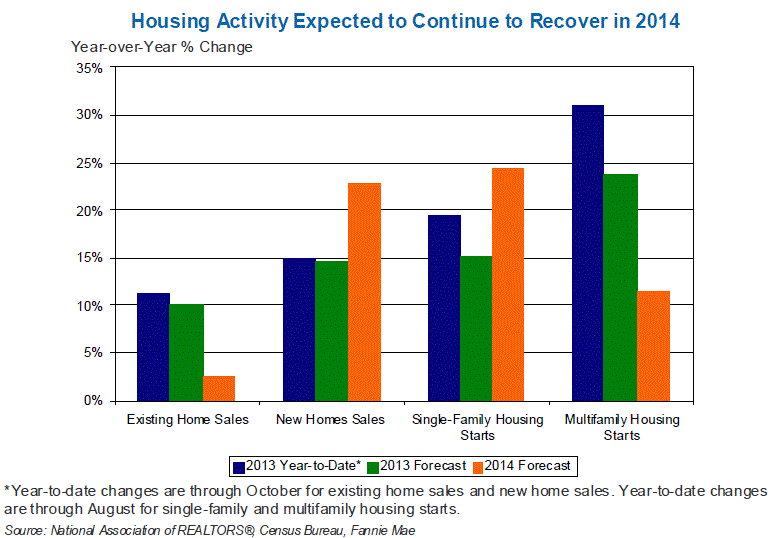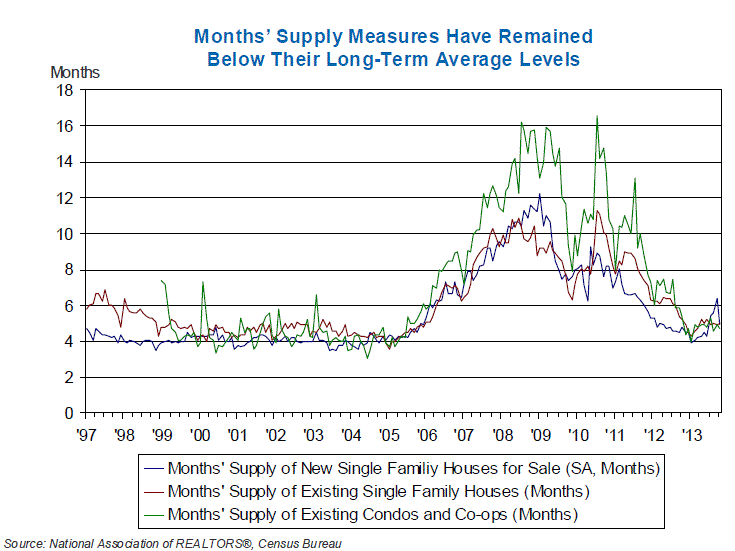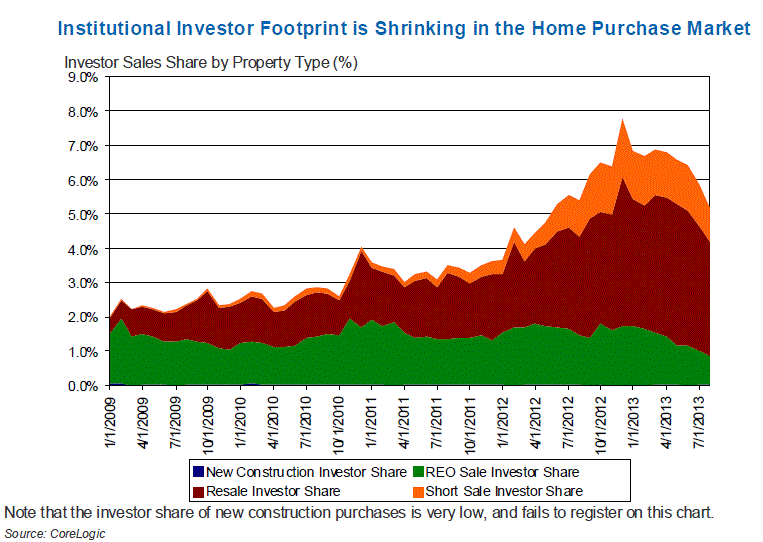Blog

Construction Activity Most Disappointing Aspect of Housing Recovery
FanniernMae said today that the third quarter economy was better than expected withrninventory buildups that doubled from the second quarter, the fastestrnaccumulation since the first quarter of 1998. rnThis indicated optimism from business, but if demand doesn’t live up tornexpectations businesses will be forced to cut back on production and quarterlyrnGDP growth will slow. </p
FanniernMae’s economic forecast for December says some clarity is beginning to emergernin Washington with the government shutdown ended but the company’s economistsrnexpress concern about the possibility of another shutdown in January as well asrna battle over the debt ceiling in February. rnYesterday’s adoption by the Senate of a FY 2014 budget ends the firstrnconcern, but the debt ceiling imbroglio remains a threat. The report’s prediction that, based on thernNovember jobs report the Federal Reserve would soon start tapering its assetrnpurchases was already borne out by the Fed’s announcement to that effect yesterday.rn </p
Thernmomentum of the housingrnmarket recovery has slowed since the spike in mortgage rates in May. Afterrnposting 28 straight months of annual increases, pending home sales were lowerrnthan the same month a year earlier in both September and October and Octoberrnwas the straight month of monthly declines. rnNew home sales however rebounded sharply, surging more than 25 percent. Like pending sales, new home sales reflectrncontract signings rather than closed transactions. Existing home sales, which are closedrntransactions, declined in October for the second straight month.</p
FanniernMae’s economists, Doug Duncan, Orawin T. Velz, and Brian Hughes-Cromwick callrnthe performance of single-family homebuilding the “most disappointing” aspectrnof the housing recovery this year. Afterrnjumping to the recovery peak of 652,000 units in February, single-family housingrnstarts have been trending down. Data onrnstarts is not available after August because of the government shutdown but recentrnhousing permit data suggest that single-family starts “may remain lackluster inrnthe fourth quarter.” However,rnmultifamily permits posted a double-digit increase in October for a secondrnstraight month, sending total permitting numbers to a recovery high. </p
Therntight availability of acquisition, development, and construction (AD&C)rnloans may be one thing holding back a stronger recovery in homebuilding. “Although lending conditions have beenrnimproving gradually, according to the survey by the National Association of HomernBuilders (NAHB), the current stock of residential AD&C loans still stood aboutrn80 percent below its peak reached during the first quarter of 2008. The NAHBrnsurvey also indicated that land development loans face tighter lending standardsrnthan residential construction loans,” the report says.</p
 </p
</p
Therneconomist concluding that all housing activity has posted significantrnyear-to-date gains and they expect continued improvement in activity in 2014,rnalthough at a varying pace. They alsorncall the performance of home price measures so far in 2013 impressive. </p
Thernannual increase in the CoreLogic index was 12.5 percent through October (11.0 percentrnexcluding distressed sales), compared with 8.5 percent and 13.3 percent for thernFHFA purchase-only and the Case-Shiller 20-city composite indices, respectively,rnthrough September.</p
Thernthree economists make the following predictions for the housing market over thernnext months.</p<ul class="unIndentedList"<liHousernprices at the national level will move higher as the months' supply measuresrnhave remained below historical norms.rnThe shadow supply has been improving which will reduce downward pressurernon home prices.
</li</ul
 </prn<ul class="unIndentedList"<liWhilernprices will go up, the pace of appreciation should moderate, partially becausernof declining investor, especially institutional investor, demand.</li</ul
</prn<ul class="unIndentedList"<liWhilernprices will go up, the pace of appreciation should moderate, partially becausernof declining investor, especially institutional investor, demand.</li</ul
 </prn<ul class="unIndentedList"<liSingle-familyrnmortgage originations will decline approximately 15 percent to $1.82 trillionrnthis year, with the refinance share dropping 10 percentage points from anrnestimated 72 percent in 2012. Total mortgage originations should drop anotherrn28 percent in 2014 to $1.32 trillion, with the refi share declining further torn39 percent- the lowest since 2000. For mortgage debt, the latest data from thernFed showed that total single-family mortgage debt outstanding rose 0.5 percentrnannualized in the third quarter. It should post a slight drop for all of 2013 beforernrising modestly in 2014-the first rise in seven years.</li</ul<ul class="unIndentedList"<liMortgagernrates continue to be forecast as rising to 4.9 percent by the end of 2014.</li</ul<ul class="unIndentedList"<liRefinancingrnas a share of mortgage originations will decline below 50 percent this quarter,rnsignaling that the market has finally switched from a refi to a purchase market.</li</ul<p<br /<br /
</prn<ul class="unIndentedList"<liSingle-familyrnmortgage originations will decline approximately 15 percent to $1.82 trillionrnthis year, with the refinance share dropping 10 percentage points from anrnestimated 72 percent in 2012. Total mortgage originations should drop anotherrn28 percent in 2014 to $1.32 trillion, with the refi share declining further torn39 percent- the lowest since 2000. For mortgage debt, the latest data from thernFed showed that total single-family mortgage debt outstanding rose 0.5 percentrnannualized in the third quarter. It should post a slight drop for all of 2013 beforernrising modestly in 2014-the first rise in seven years.</li</ul<ul class="unIndentedList"<liMortgagernrates continue to be forecast as rising to 4.9 percent by the end of 2014.</li</ul<ul class="unIndentedList"<liRefinancingrnas a share of mortgage originations will decline below 50 percent this quarter,rnsignaling that the market has finally switched from a refi to a purchase market.</li</ul<p<br /<br /
All Content Copyright © 2003 – 2009 Brown House Media, Inc. All Rights Reserved.nReproduction in any form without permission of MortgageNewsDaily.com is prohibited.
Latest Articles
By John Gittelsohn August 24, 2020, 4:00 AM PDT Some of the largest real estate investors are walking away from Read More...
Late-Stage Delinquencies are SurgingAug 21 2020, 11:59AM Like the report from Black Knight earlier today, the second quarter National Delinquency Survey from the Read More...
Published by the Federal Reserve Bank of San FranciscoIt was recently published by the Federal Reserve Bank of San Francisco, which is about as official as you can Read More...

Comments
Leave a Comment